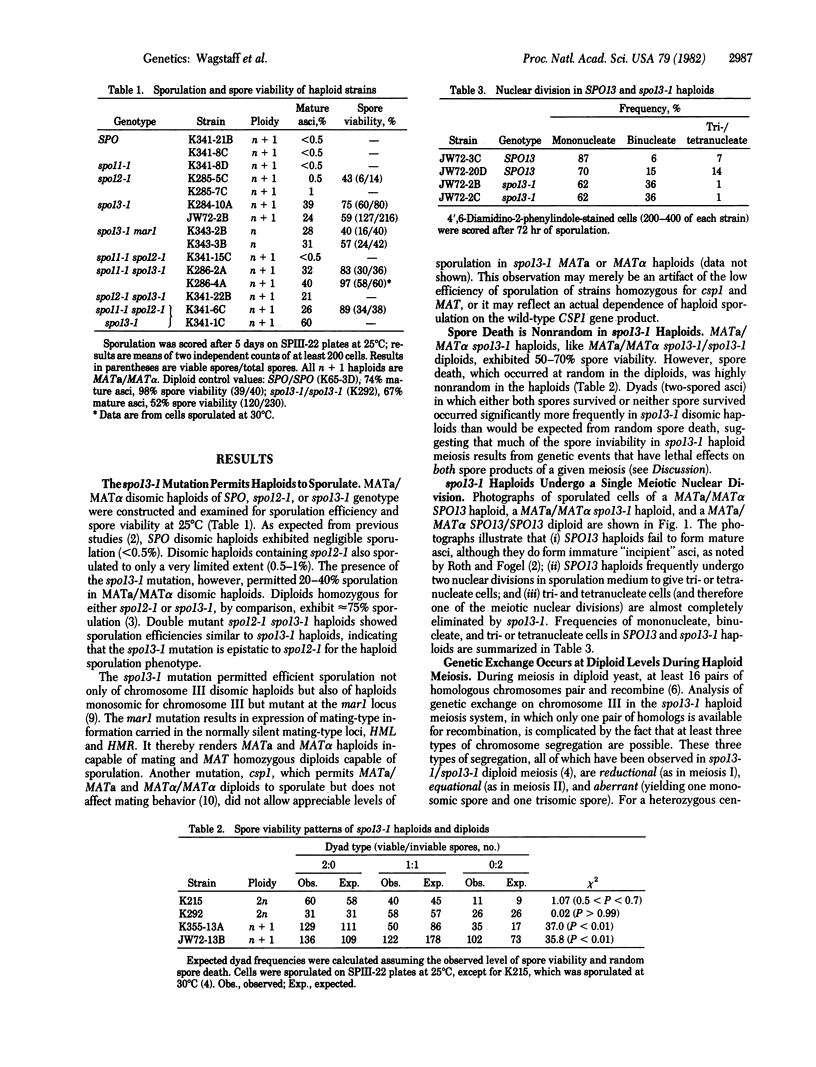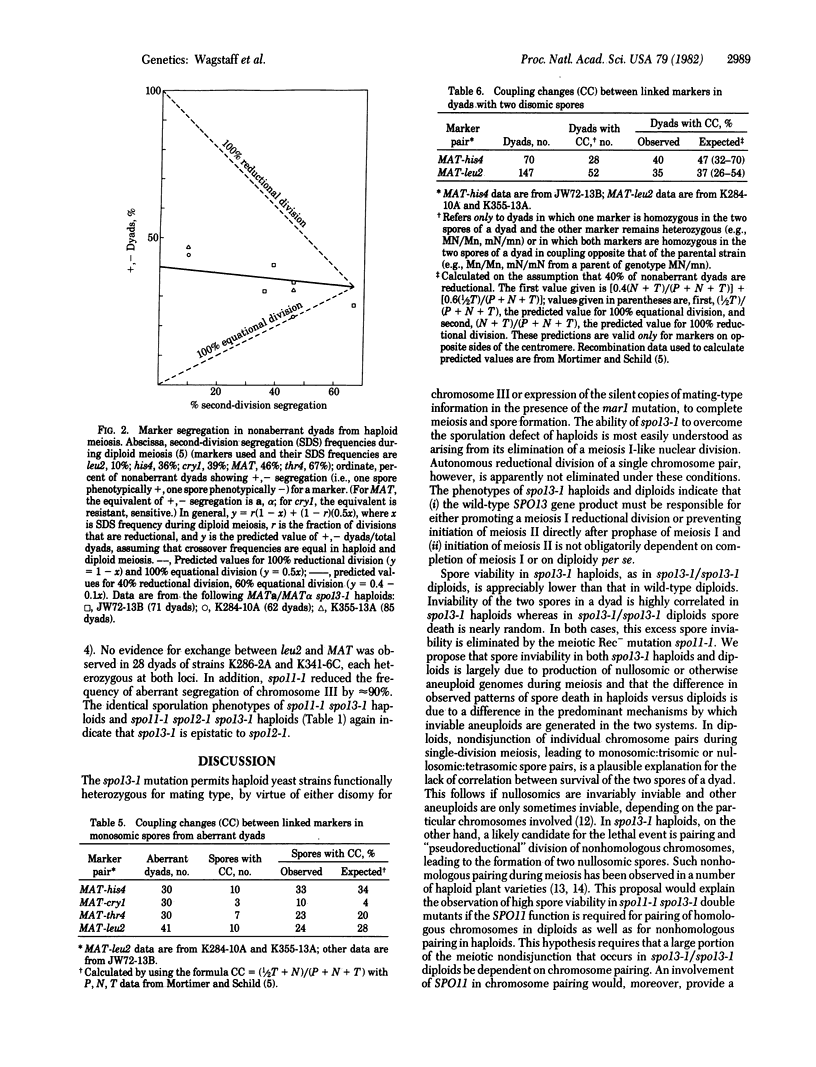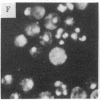Abstract
Haploid yeast cells normally contain either the MATa or MATα mating-type allele and cannot undergo meiosis and spore formation. If both mating-type alleles are present as a consequence of chromosome III disomy (MATa/MATα), haploids initiate meiosis but do not successfully form spores, probably because the haploid chromosome complement is irregularly partitioned during meiotic nuclear division. We have demonstrated that the ochre-suppressible mutation spo13-1 enables haploid yeast cells disomic for chromosome III and heterozygous at the mating-type locus to complete meiosis and spore formation, yielding two haploid spores. Previous studies have shown that the absence of the wild-type SPO13 gene function permits diploid cells to bypass homologous chromosome segregation at meiosis I and proceed directly to meiosis II. During spo13-1 haploid meiosis, cells enter prophase of meiosis I. Genetic recombination, monitored on the chromosome III disome, occurs at levels similar to those seen in diploids, indicating that the level of exchange between homologs is an autonomous property of individual chromosomes and not dependent on exchange elsewhere in the genome. Exchange is then followed by a single meiosis II equational chromosome division. Recombination in spo13-1 haploids is blocked by the spo11-1 mutation, which also eliminates recombination between homologous chromosomes during conventional diploid meiosis. We conclude that Spo+ haploids expressing both a and α mating-type information attempt a SPO13-dependent meiosis I division, and that this division, in the absence of paired homologous chromosomes, is responsible for the failure of such haploids to complete normal gametogenesis. Our observations support the conclusion that initiation and completion of meiosis II and spore formation are not dependent on either completion of meiosis I or the presence of a diploid chromosome complement.
Keywords: sporulation, chromosome segregation, recombination
Full text
PDF




Images in this article
Selected References
These references are in PubMed. This may not be the complete list of references from this article.
- Bruenn J., Mortimer R. K. Isolation of monosomics in yeast. J Bacteriol. 1970 May;102(2):548–551. doi: 10.1128/jb.102.2.548-551.1970. [DOI] [PMC free article] [PubMed] [Google Scholar]
- Hopper A. K., Kirsch J., Hall B. D. Mating type and sporulation in yeast. II. Meiosis, recombination, and radiation sensitivity in an alpha-alpha diploid with altered sporulation control. Genetics. 1975 May;80(1):61–76. doi: 10.1093/genetics/80.1.61. [DOI] [PMC free article] [PubMed] [Google Scholar]
- Klapholz S., Esposito R. E. Isolation of SPO12-1 and SPO13-1 from a natural variant of yeast that undergoes a single meiotic division. Genetics. 1980 Nov;96(3):567–588. doi: 10.1093/genetics/96.3.567. [DOI] [PMC free article] [PubMed] [Google Scholar]
- Klapholz S., Esposito R. E. Recombination and chromosome segregation during the single division meiosis in SPO12-1 and SPO13-1 diploids. Genetics. 1980 Nov;96(3):589–611. doi: 10.1093/genetics/96.3.589. [DOI] [PMC free article] [PubMed] [Google Scholar]
- Klar A. J., Fogel S., Macleod K. MAR1-a Regulator of the HMa and HMalpha Loci in SACCHAROMYCES CEREVISIAE. Genetics. 1979 Sep;93(1):37–50. doi: 10.1093/genetics/93.1.37. [DOI] [PMC free article] [PubMed] [Google Scholar]
- Klar A. J. Mating-Type Functions for Meiosis and Sporulation in Yeast Act through Cytoplasm. Genetics. 1980 Mar;94(3):597–605. doi: 10.1093/genetics/94.3.597. [DOI] [PMC free article] [PubMed] [Google Scholar]
- Klein H. L., Petes T. D. Intrachromosomal gene conversion in yeast. Nature. 1981 Jan 15;289(5794):144–148. doi: 10.1038/289144a0. [DOI] [PubMed] [Google Scholar]
- Malone R. E., Esposito R. E. Recombinationless meiosis in Saccharomyces cerevisiae. Mol Cell Biol. 1981 Oct;1(10):891–901. doi: 10.1128/mcb.1.10.891. [DOI] [PMC free article] [PubMed] [Google Scholar]
- Mortimer R. K., Schild D. Genetic map of Saccharomyces cerevisiae. Microbiol Rev. 1980 Dec;44(4):519–571. doi: 10.1128/mr.44.4.519-571.1980. [DOI] [PMC free article] [PubMed] [Google Scholar]
- Petes T. D. Unequal meiotic recombination within tandem arrays of yeast ribosomal DNA genes. Cell. 1980 Mar;19(3):765–774. doi: 10.1016/s0092-8674(80)80052-3. [DOI] [PubMed] [Google Scholar]
- Rabin M. S., Bledin A. G., Price H. I. Pneumatosis coli secondary to colonic obstruction. A case report. S Afr Med J. 1978 Jun 24;53(26):1078–1079. [PubMed] [Google Scholar]
- Roth R., Fogel S. A system selective for yeast mutants deficient in meiotic recombination. Mol Gen Genet. 1971;112(4):295–305. doi: 10.1007/BF00334431. [DOI] [PubMed] [Google Scholar]
- Williamson D. H., Fennell D. J. The use of fluorescent DNA-binding agent for detecting and separating yeast mitochondrial DNA. Methods Cell Biol. 1975;12:335–351. doi: 10.1016/s0091-679x(08)60963-2. [DOI] [PubMed] [Google Scholar]










